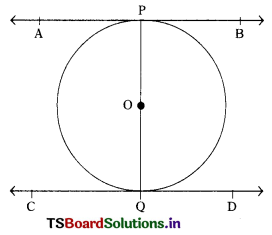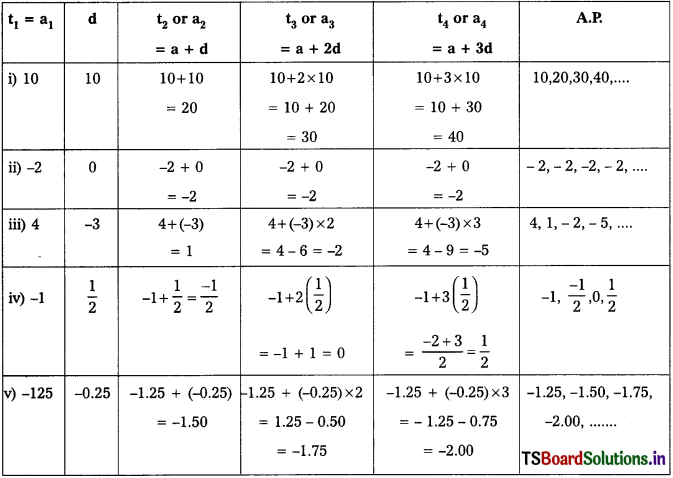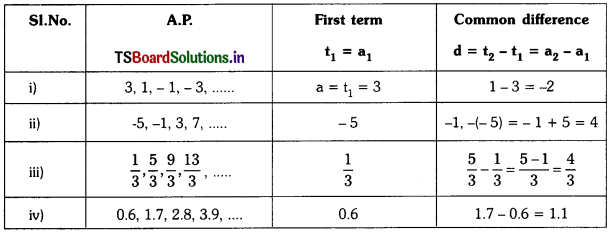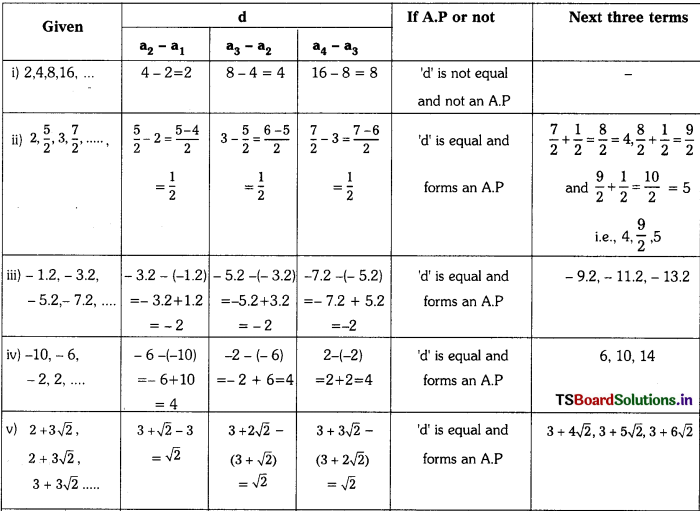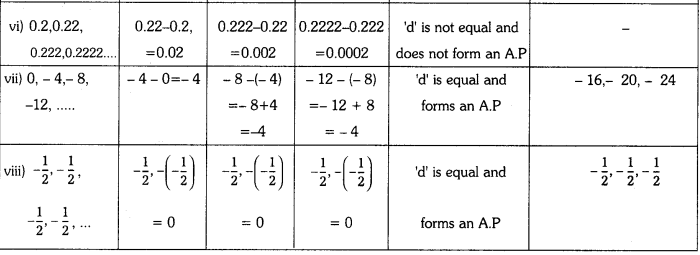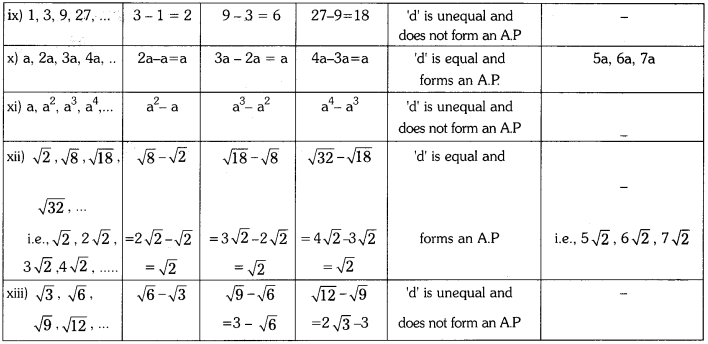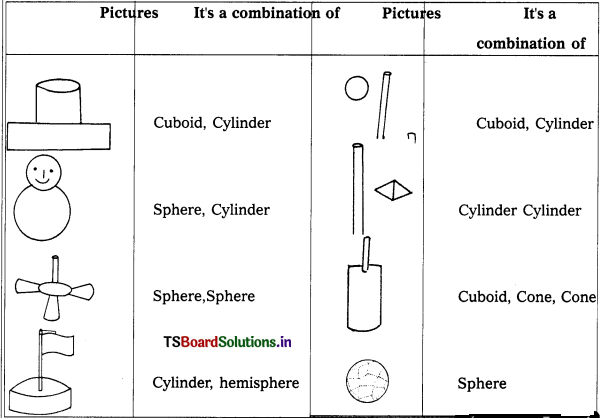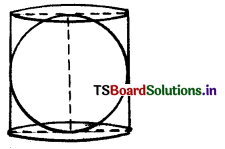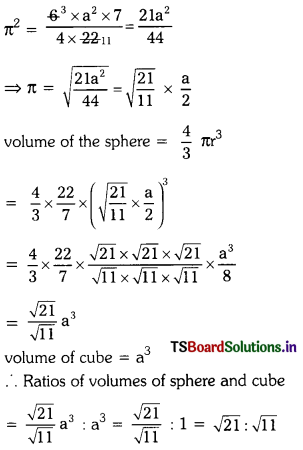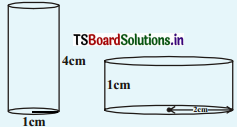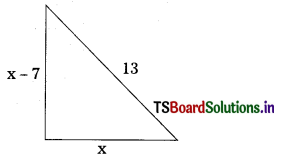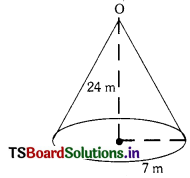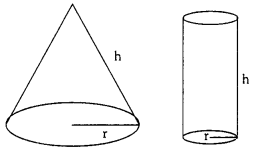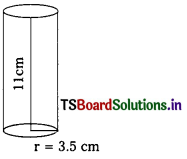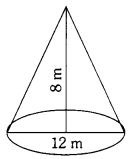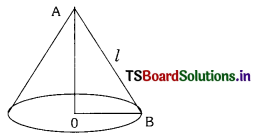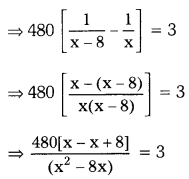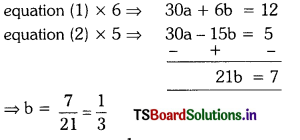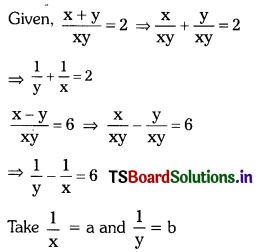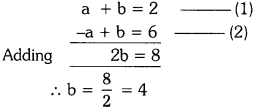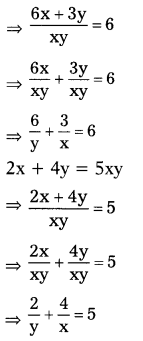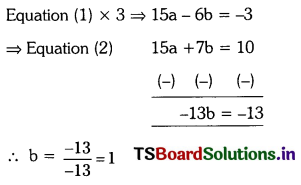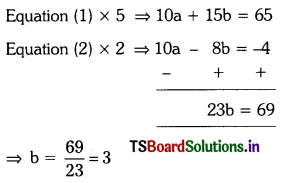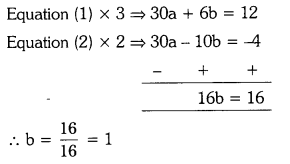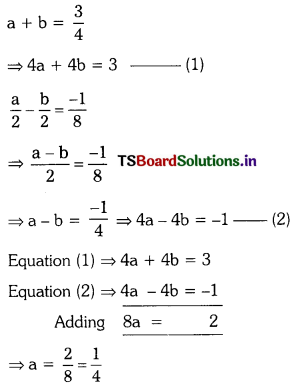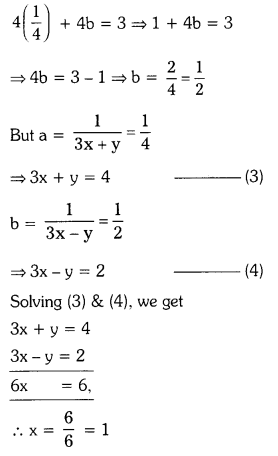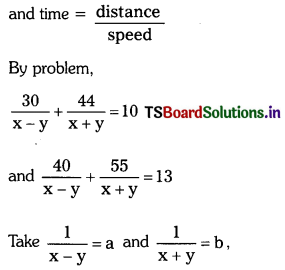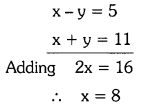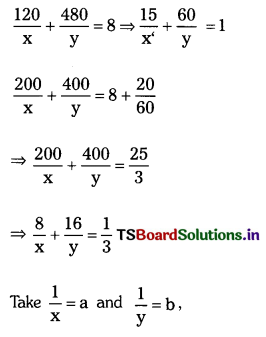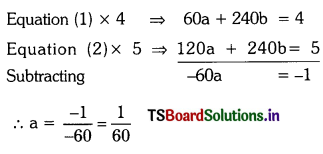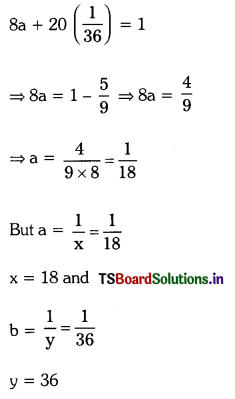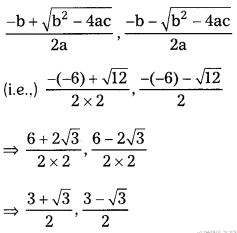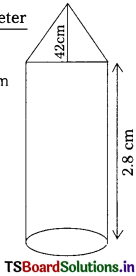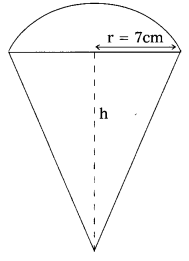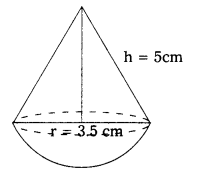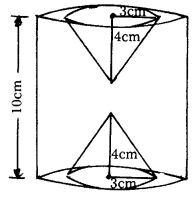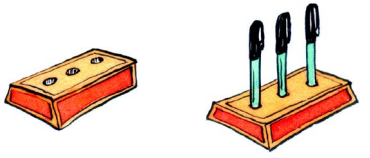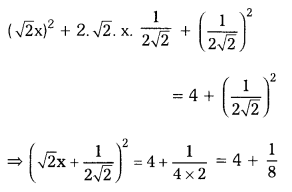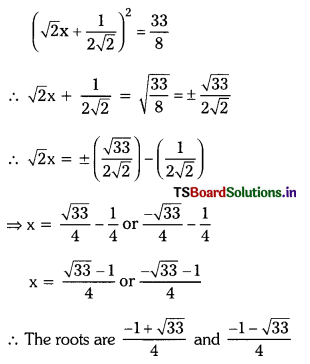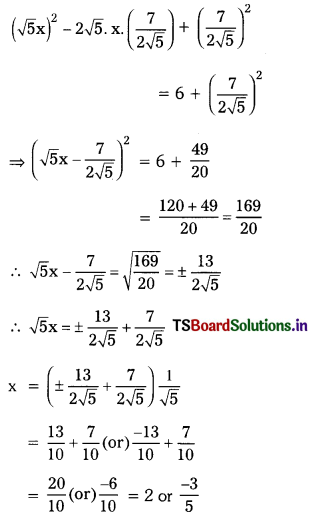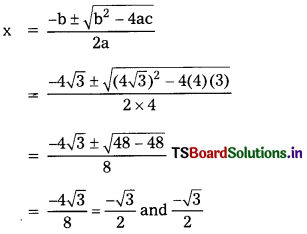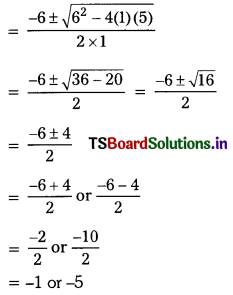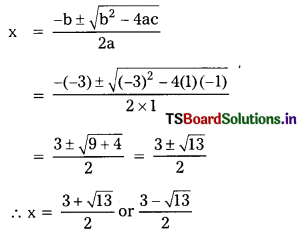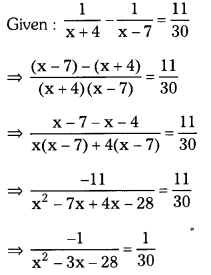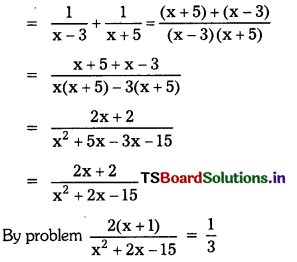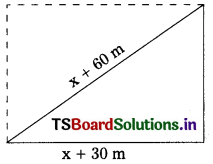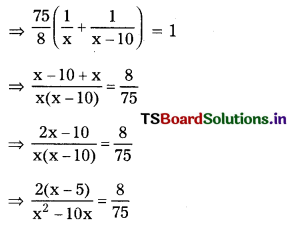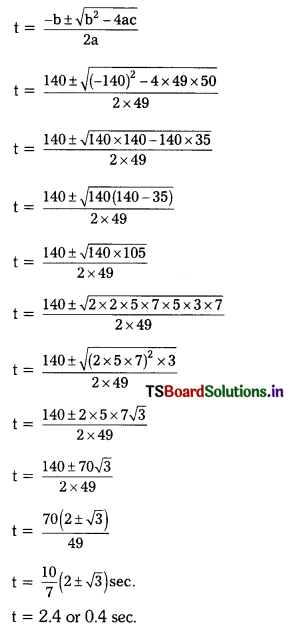Telangana SCERT 10th Class Physics Study Material Telangana 1st Lesson Reflection of Light at Curved Surfaces Textbook Questions and Answers.
TS 10th Class Physical Science 1st Lesson Questions and Answers Reflection of Light at Curved Surfaces
Improve Your Learning
I. Reflections on concepts
Question 1.
Where will the image be formed when we place an object, on the principal axis of a concave mirror at a point between focus and centre of curvature?
Answer:
1. When we place an object on the principal axis of concave mirror at a point between focus and centre of curvature, the image is formed beyond centre of curvature.
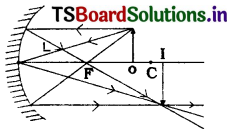
2. The image so formed is real, inverted and magnified.
Question 2.
State the differences between convex and concave mirrors.
Answer:
| Convex mirror | Concave mirror |
| 1. A parallel beam of light falling on this mirror appears to diverge from a point after reflection. | 1. A parallel beam of light falling on this mirror converges at a point after reflection. |
| 2. The reflecting surface of convex mirror is bulged out. | 2. The reflecting surface of a concave mirror curve inward. |
| 3. Radius of curvature and focal length are negative. | 3. Radius of curvature and focal length are positive. |
| 4. It’s magnification has positive only. | 4. It’s magnification has both positive and negative. |
| 5. Magnification of convex mirror is in between zero and one. | 5. Magnification value of concave mirror having all values except zero to one. |
| 6. The image formed by convex mirror always diminished. | 6. The image formed by concave mirror may be magnified or diminished. |
| 7. This mirror produces only virtual image. | 7. This mirror produces both real and virtual images depending upon position of object. |
Question 3.
Distinguish between real and virtual images.
Answer:
| Real image | Virtual image |
| 1. Real image is formed if light after | 1. Virtual image is formed when rays reflection or refraction converges after reflection appear to be comto a point. ing from a point. |
| 2. Here the rays actually meet at the from the image point. | 2. Here the rays appear to diverge image point. |
| 3. It can be captured on screen. | 3. It cannot be captured on screen. |
| 4. It is always inverted. | 4. It is always erect. |

Question 4.
How do you get a virtual image using a concave mirror?
Answer:
A. When an object is kept between pole and focus of a concave mirror virtual image is formed behind the mirror.
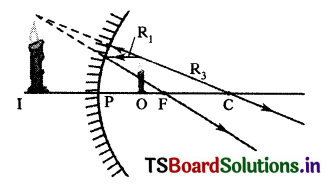
Question 5.
What do you know about the terms given below related to spherical mirrors?
(a) pole
(b) centre of curvature
(c) focus
(d) Radius of curvature
(e) Focal length
(f) principal axis
(g) object distance
(h) image distance
(i) Magnification.
Answer:
(a) Pole: The point on the principal axis of spherical mirror with respect to which all the measurements are made. Usually, it is the mid point of the curvature of mirror.
(b) Centre of curvature: The centre of the sphere of which the curved surface of the mirror is a part.
(c) Focus: The light rays coming from a source parallel to the principal axis converge at a point after reflection. This point is called focus or focal point.
(d) Radius of curvature: The radius of the sphere of which the curved surface is a part is called radius of curvature.
(e) Focal length: The distance between the pole of the mirror and focus is called focal length of mirror.
(f) Principal axis: The straight line passing through the centre of curvature and pole of curved mirror is called principal axis.
(g) Object distance: The distance between the pole of the mirror and object position of object is known as object distance.
(h) Image distance: The distance between the pole of the mirror and position of image is called image distance.
(i) Magnification: Magnification of a spherical mirror is the ratio between size (height) of image to the size (height) of object. Also, m= v/u.
Question 6.
What do you infer from the experiment which you did to measure the object distance and image distance?
Answer:
Inference from the experiment which I did with concave mirror :
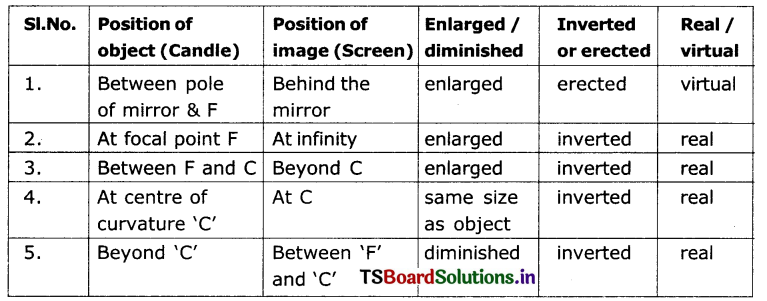
Inference:
- As the object moves away from the mirror the image approaches the mirror.
- As the object moves away from mirror the size of the image becomes smaller.
Question 7.
Write the rules for sign convention.
Answer:
Rules for sign convension:
- AN distances should be measured from the pole.
- The distances measured in the direction of incident light, are taken positive and the opposite direction of incident light are taken negative.
- Height of object (H0) and height of image (H1) are positive if measured upward
from the axis and negative if measured downward. - For a concave mirror ‘f’ and ‘R’ are negative and for a convex mirror these are positive.
II. Application of concepts
Question 1.
Find the distance of the image, when an object is placed on the principal axis, at a distance of 10 cm in front of a concave mirror whose radius of curvature is 8 cm.
Answer:
Object distance u = -10 cm
Radius of curvature (r) = -8cm
Image distance v=?

The image distance (v) = 6.7 cm.
i.e., Real image is formed at same side of the mirror.

Question 2.
The magnification product by a plane mirror is +1. What does it mean?
Answer:
- Magnification = \(\frac{\text { height of the image }}{\text { height of the object }}=\frac{\text { distance of the image }}{\text { distance of the object }}\)
- The magnification produced by a plane mirror is +1 means then the size of the image is equal to the size of the object.
- + sign indicates that the image is erect. Magnification ‘+1’ indicates the image is erect and size of the image is equal to size of the object.
Question 3.
If the spherical mirrors were not known to human beings, guess the consequences.
Answer:
If spherical mirrors are not known to human beings
- Many optical instruments would not have been invented.
- We cannot increase the size of images of the objects.
- The problem of lateral inversion of images will not be solved.
- Now a days spherical mirrors are used as shaving mirrors, head mirrors for ENT specialists, in headlights of motor vehicles, in solar furnaces and as rearview mirror. If spherical mirrors are not known all these are not possible.
Question 4.
Draw suitable rays by which we can guess the position of the imge formed by a concave mirror.
Answer:
The following rays are used to guess the position of the image formed by a concave mirror.
(i) A ray parallel to the principal axis passes through principal focus (F) after reflection from a concave mirror.
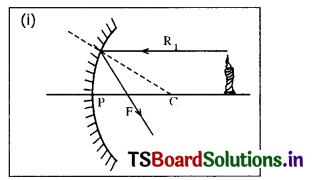
(ii) A ray passing through ‘F’ becomes parallel to principal axis after reflection from a concave mirror.
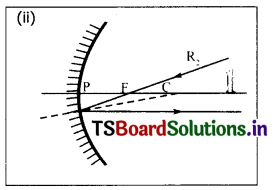
(iii) A ray passing through ‘C’ is reflected back along the same path after reflection from a concave mirror.
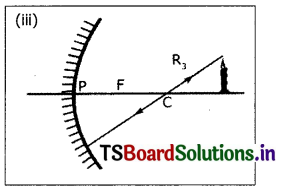
(iv) A ray incident obliquely to the principal axis towards the pole P, on the concave mirror is reflected obliquely, following the laws of reflection.
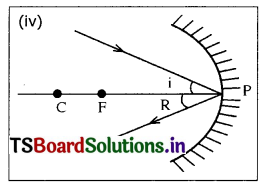
Question 5.
Show the formation of image with a ray diagram, when an object is placed on the principal axis of a concave mirror away from the centre of curvature.
Answer:
When an object is placed on the principal axis of a concave mirror and beyond (away from) its centre of curvature ‘C’, the image is formed between the focus (F) and the centre of curvature (C). The ray which is parallel to principle axis will pass through focus after reflection and the ray which passes through focus will travels parallel to principal axis after reflection. These two rays will converge between F and C of the mirror.
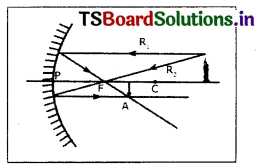
The image is real, inverted and diminished in size.
Question 6.
Why do we prefer a convex mirror as a rear-view mirror in the vehicles?
Answer:
We use convex mirror as a rear-view mirror in the vehicles because
- Convex mirror always forms virtual, erect, and diminished images irrespective of distance of the object.
- A convex mirror enables a driver to view large area of the traffic behind him.
- Convex mirror forms very small image than the object. Due to this reason convex mirrors are used as rear-view mirrors in vehicles.

III. Higher Order Thinking Questions
Question 1.
A convex mirror with a radius of curvature of 3 m is used as a rearview mirror for a vehicle. If a bus is located at 5m from this mirror, find the position, nature, and size of the image.
Answer:
According to the sign convention :
Radius of curvature = R = + 3m
Object distance = u = -5 m (negative sign)
Image distance = v =?
Focal length, f = \(\frac{R}{2}=\frac{3}{2} m\) = 1.5 m
Formula : \(\frac{1}{f}=\frac{1}{u}+\frac{1}{v}\)

The image is formed at a distance of 1.15 m at the back of the mirror.
Magnification, m = \(\frac{h_i}{h_o}=-\frac{v}{u}=\frac{-1.15 m}{-5 m}=\frac{1.15}{5}\) = 0.23
The image is virtual, erect, and diminished to 0.23 times of the size of the object.
Question 2.
To form the image on the object itself, how should we place the object in front of a concave mirror? Explain with a ray diagram.
Answer:
To form the image on the object itself, the object should be kept at center of curvature of a concave mirror.
- An object AB has been placed at the centre of curvature ‘C’ on the concave mirror.
- A ray of light AD which is parallel to principle axis passes through the focus ‘F after reflection as DA’.
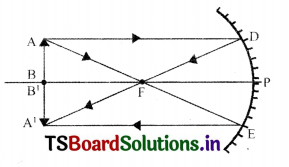
- A ray of light passing through the focus of the concave mirror becomes parallel to the principle axis after reflection.
- Here AE ray passing through focus and reflected as EA’.
- The reflected rays DA’ and EA’ meet at A’ point. So the real image formed at point A’ of the object.
We get couple image AB perpendicular to the principal axis. - Thus A’B’ is the real inverted image of the object AB.
IV. Multiple choices questions
Question 1.
If an object is placed at ‘C’ on the principal axis in front of a concave mirror, the position of the image is ………………. . [ ]
(a) at infinity
(b) between F and C
(c) at C
(d) beyond C
Answer:
(c) at C
Question 2.
We get a diminished image with a concave mirror when the object is placed ………………………. . [ ]
(a) at F
(b) between the pole and F
(c) at C
(d) beyond C
Answer:
(d) beyond C
Question 3.
We get a virtual image in a concave mirror when the object is placed …………………….. . [ ]
(a) at F
(b) between the pole and F
(c) at C
(d) beyond C
Answer:
(b) between the pole and F
Question 4.
Which of the following represents Magnification? [ ]
(i) \(\frac{v}{u}\)
(ii) \(\frac{-v}{u}\)
(iii) \(\frac{h_i}{h_0}\)
(iv) \(\frac{h_0}{h_i}\)
(a) i, ii
(b) ii, iii
(c) iii, iv
(d) iv, i
Answer:
(d) iv, i
Question 5.
ray which seems to be traveling through the focus of a convex mirror, path of the reflected ray of an incident ……………… . [ ]
(a) parallel to the axis
(b) along the same path in opposite direction
(c) through F
(d) through C
Answer:
(a) parallel to the axis

Question 6.
Size of image formed by a convex mirror is always …………………… .[ ]
(a) enlarged
(b) diminished
(c) equal to the size of object
(d) depends on position of object
Answer:
(b) diminished
Question 7.
An object is placed at a certain distance on the principal axis of a concave mirror. The image is formed at a distance of 30 cm from the mirror. Find the object distance if radius of curvature R = 15cm. [ ]
(a) 15 cm
(b) 10 cm
(c) 30 cm
(d) 7.5 cm
Answer:
(c) 30 cm
Question 8.
All the distances related to spherical mirror will be measured from …………………… .[ ]
(a) object to image
(b) focus of the mirror
(c) pole of the mirror
(d) image to object
Answer:
(c) pole of the mirror
Question 9.
The minimum distance from real object to a real image in a concave mirror is ………………….. . [ ]
(a) 2f
(b) f
(c) 0
(d) f/2
Answer:
(c) 0
Suggested Experiments
Question 1.
Conduct an experiment to find the focal length of concave mirror.
(or)
How can you find out the focal length of concave mirror experimentally when there is no sunlight?
Answer:
Aim: To find the focal length of a concave mirror,
Materials required : (i) A concave mirror (ii) V-shape stand (iii) A candle (iv) A meter scale.

Procedure :
- Place the concave mirror on the V-shape stand.
- Keep a burning candle in front of the concave mirror.
- Place a thick white paper behind the candle. This acts as a screen.
- Adjust distances between candle and mirror, screen and mirror by moving them either forward or backward till a clear well-defined image appears on the screen.
- Measure the distance between the mirror and candle (object distance u) and the distance between mirror and screen (image distance v).
- Using the mirror formula, \(\frac{1}{f}=\frac{1}{u}+\frac{1}{v} \) or f = \(\frac{u v}{u+v} \)
This gives the focal length of the concave mirror.
Question 2.
Find the nature and position of images when an object is placed at different places on the principal axis of a concave mirror.
Answer:
Aim: Observing the types of images and measuring the object distance and image distance from the concave mirror.
Material required: A candle, paper, concave mirror (known focal length), V- stand, measuring tape or meter scale.
Procedure:
- Place the concave mirror on V-stand, a candle and meter scale as shown in figure.

- Keep the candle at different distances from the mirror (10 cm to 80 cm) along the axis and by moving the paper screen find the position where you get the sharp image on paper.
- Note down your observations in the following table.
- Since we know the focal point and centre of curvature, we can classify our above observations as shown in the following table.

Suggested Project Works
Question 1.
Collect information about the history of spherical mirrors in human civilization, write a report on it.
Answer:
- The first mirrors used by people were most likely pools of water or still water. The earliest manufactured mirrors were pieces of polished stones.
- Parabolic mirrors were described and studied in classical antiquity by the mathematician Archimedes in his work on burning mirrors.
- Ptolemy conducted a number of experiments with curved polished iron mirrors. He also discussed plane, convex, concave, and spherical mirrors in his optics.
- In China, people began making mirrors with the use of silver mercury amalgams as early as 500 AD.
- In 16th century, Venice, a big city popular for its glass-making expertise, became a centre of mirror production using this new technique.
- The invention of the silvered-glass mirror is credited to German Chemist Justus Von Liebig in 1835.

Question 2.
Think about the objects which act as concave or convex mirrors in your surroundings. Make a table of these objects and display in your classroom.
Answer:
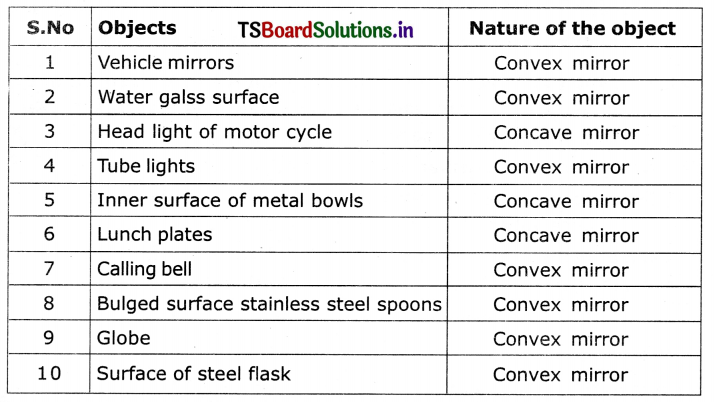
Question 3.
Collect photographs from your daily life where you use convex and concave mirrors and display in your classroom.
Answer:
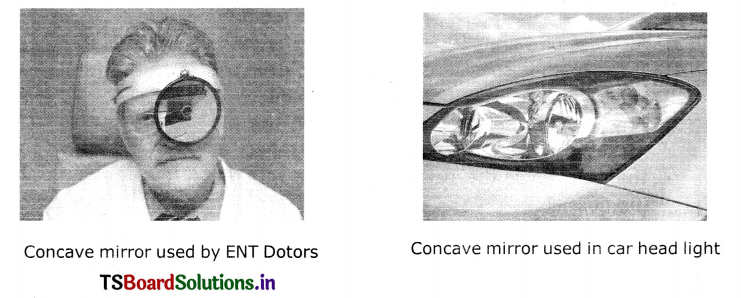
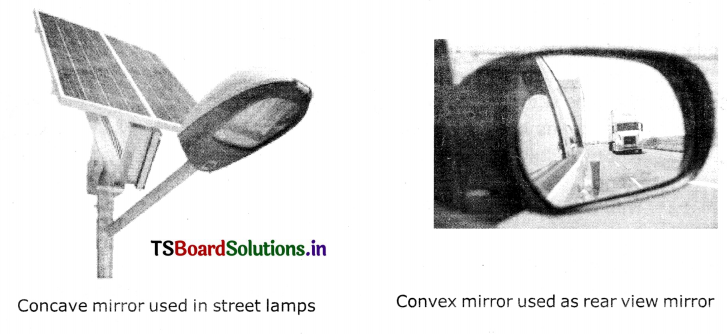
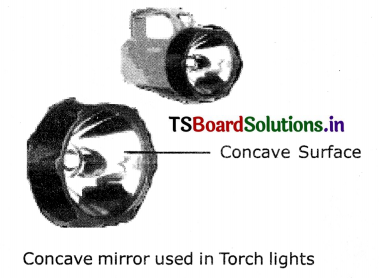
TS 10th Class Physical Science Reflection of Light at Curved Surfaces Intext Questions
Page 1
Question 1.
Is the image formed by a bulged surface same as the image formed by a plane mirror?
Answer:
No, the image formed by a bulged surface is virtual, created, and diminished image.
Question 2.
Is the mirror used in automobiles a plane mirror? Why it is showing small images?
Answer:
No, the mirror used in automobile is convex mirror. At it bulging outwards it forms small images.
Question 3.
Why does our image appear thin or bulged out in some mirrors?
Answer:
The image in a mirror appears thin or bulged out because the thickness of the mirror may vary or the reflecting surface may not be flat.

Question 4.
Can be see inverted image in any mirror?
Answer:
Can we see inverted image in any mirror? Yes, we can see inverted image in concave mirror for a distant objects.
Question 5.
Can we focus the sunlight at a point using a mirror instead of a magnifying glass?
Answer:
Yes. By using a black paper with a tiny hole at its centre.
Question 6.
Are the angle of reflection and angle of incidence also equal for reflection by curved surfaces?
Answer:
No.
Page 4
Question 7.
Does this help you to verify the conclusions you arrived at with your drawing?
Answer:
Yes.
Question 8.
What happens if you hold the paper at a distance shorter than the focal length from the mirror and move it away?
Answer:
We find there is no point at which the reflected rays converge at a point. But as we move the paper away from the focal point, we find images formed at different distances from the mirror.
Question 9.
Does the image of the sun become smaller or bigger?
Answer:
We notice that the image of the sun keeps on becoming smaller. Beyond the focal point, it will become bigger.
Page 5
Question 10.
Do we get an image with a concave mirror at the focus every time?
Answer:
We get the images not only at the focus every time, we get different ¡mages by keeping the object at different points depending on focal length of mirror.
Page 6
Question 11.
It is inverted or erect, enlarged or diminished?
Answer:
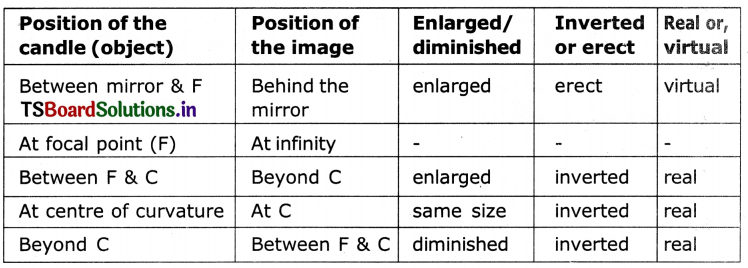
Question 12.
What do you infer from the table?
Answer:
From the table 2. I infer that images can be formed at other positions different from focal point.
Page 7
Question 13.
Why only at point A?
Answer:
If we hold the screen at any point before or beyond point A (for example at point B), we see that the rays will meet the screen at different points due to these rays. If we draw more rays emanating from the same tip we will see that
at point A they will meet but at point B they do not. So the image of the tip of the flame will be sharp at point A.
Page 9
Question 14.
Where is the base of the candle expected to be in the image when the candle is placed on the axis of the mirror?
Answer:
The base of the candle is going to be on the principle axis ¡n the image when the object is placed on the axis of the mirror.
Question 15.
During the experiment, did you get any positions where you could not get an image on the screen?
Answer:
Yes. When the object is placed at a distance less than the focal length of the mirror we do not get an ¡mage on the screen.
Page 11
Question 16.
Have you observed the rearview mirrors of a car?
Answer:
Yes. I have observed rear view mirror of a car.

Question 17.
What type of surface do they have?
Answer:
A concave mirror will be like the rubber sole bent inwards and the reflecting surface will be curved inwards.
Question 18.
Can we draw ray diagrams for convex surface?
Answer:
We can draw ray diagrams with convex surface by making use of “easy” rays that we have identified, with small modifications.
Think and discuss
Question 1.
See the figure – 5 In text. A set of parallel rays are falling on a convex mirror. What conclusions can you draw from this?
Answer:
On seeing figure 5, the following conclusions can be drawn;
- The parallel beam of rays meet at infinity.
- So the Image Is not visible. :
- This parallel beam of rays forms a virtual image which is smaller than the size of object.
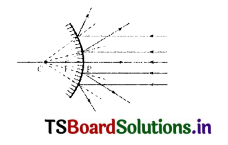
Question 2.
Will you get a point Image If you place a paper at the focal point?
Answer:
No. These parallel beam of rays do not meet at a visible point and we do not get a point image.
Question 3.
Do you get an image when object is placed at F? Draw a ray diagram. Do the experiment.
Answer:
We did not get the image when the object is placed at Focus ‘F’ of concave mirror.
Experiment:
Aim: Observing the Image formed by the object which is placed at ‘F’ of concave mirror.
Materal required: A candle, paper, a concave mirror (known focal length), V-stand, measuring
tape or meter scale.
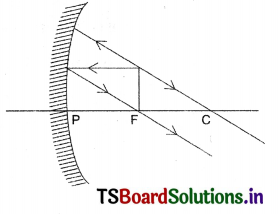
Procedure:
1. Place the concave mirror on V-stand, a candle and meter scale as shown in figure.

2. Keep the candle at a distance equal to the focal length of the mirror. (which Is known)
3. Now move the paper screen away from the mirror along the axis to observe the image.
4. You will notice that the image cannot be seen because it Is formed at infinity.
TS 10th Class Physical Science Reflection of Light at Curved Surfaces Activities
Activity 1
Question 1.
Explain an activity to find the normal to a curved surface.
Answer:
- Take a small piece of thin foam or rubber.
- Put some pins in a straight line on the foam.
- All these pins are perpendicular to the foam.
- If the foam is considered as a mirror, each pin would represent the normal at that point.
- Any ray incident at the point where the pin makes contact with the surface will reflect at the same angle the incident ray made with the pin-normal.
- Now bend the foam piece inwards.
- The pins still represent the normal at various poInts.
- You will observe that all the pins tend to coverage at a point.
- This will be appear like a concave mirror.
- Now bend the foam piece outwards.
- The pins seem to move away from each other that means they diverge.
- The pins still represent the normal at various points.
- This will be appear like a convex mirror.
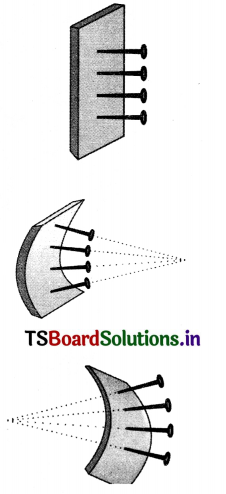
Activity 2
Question 2.
How do you Identify the focal point and foal length of a concave mirror?
Answer:
Hold a concave mirror perpendicular to me direction of sunlight
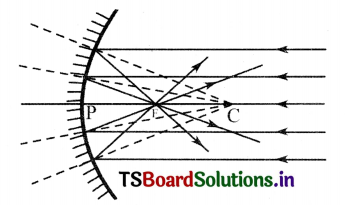
- Take a small paper and slowly move it in front of the mirror.
- Find the point where you get smallest and brigh – test spot, which is the image of the sun.
- The rays coming from the sun parallel to the concave mirror are converging at a point. This point is called focus or focal point (F) of the concave mirror.
- Measure the distance of this spot from the pole (P) of the mirror.
- ThIs distance Is the focal length (f) of the mirror
Lab Activity
Question 1.
Describe an experiment to observe types of mages formed by e concave mirror and measure the object end image distances.
(OR)
Write the experimental method in measuring the distances of object and image using concave mirror. And write the table For observations.
Answer:
Aim: Observing the types of images and reasoning the object distance and image distance from the concave mirror.
Material required: A candle, paper, concave minor (known focal length), V- stand, moesunng tape or meter scale.
Procedure
1. Place the concave mirror on V-stand, a candle and meter scale as shown in figure.

2. Keep the candle at different distances from the mIrror (10 cm to 80 cm) along the axis and by moving the paper screen fd the position where you get the sharp mage on paper.
3. Note down your observations in the following table.
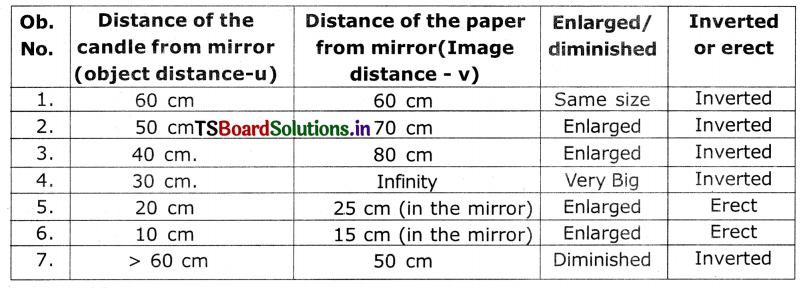
4. Since we know the focal point and centre of curvature, we can re-classify our above observations as shown in the following table.

![]()

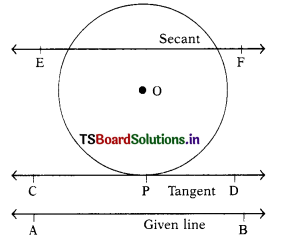
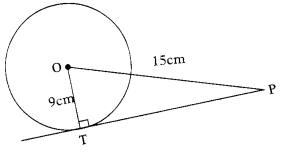
![]()
